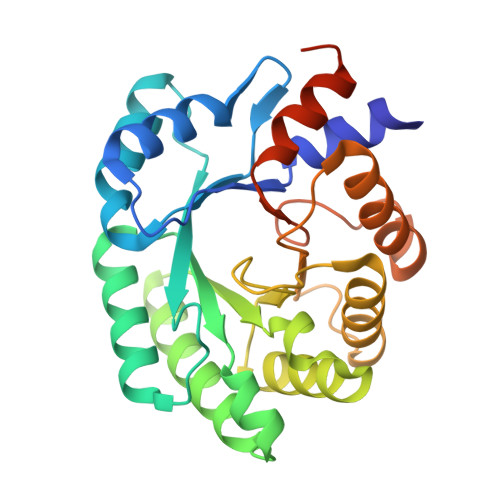Mechanism-based inhibition of an aldolase at high concentrations of its natural substrate acetaldehyde: structural insights and protective strategies.
Dick, M., Hartmann, R., Weiergraber, O.H., Bisterfeld, C., Classen, T., Schwarten, M., Neudecker, P., Willbold, D., Pietruszka, J.(2016) Chem Sci 7: 4492-4502
- PubMed: 30155096
- DOI: https://doi.org/10.1039/c5sc04574f
- Primary Citation of Related Structures:
5EKY, 5EL1, 5EMU - PubMed Abstract:
2-Deoxy-d-ribose-5-phosphate aldolase (DERA) is used in organic synthesis for the enantioselective reaction between acetaldehyde and a broad range of other aldehydes as acceptor molecules. Nevertheless, its application is hampered by a poor tolerance towards high concentrations of acetaldehyde, its natural substrate. While numerous studies have been performed searching for new, more acetaldehyde-resistant DERAs, the mechanism underlying this deactivation process has remained elusive. By using NMR spectroscopy on both the protein and the small-molecule scale, we could show that a reaction product binds to the inner part of the enzyme, and that this effect can be partly reversed via heating. The crystal structure of DERA before and after acetaldehyde incubation was determined at high resolution, revealing a covalently bound reaction product bridging the catalytically active lysine (K167) to a nearby cysteine (C47) in the deactivated enzyme. A reaction mechanism is proposed where crotonaldehyde as the aldol product of two acetaldehyde molecules after water elimination forms a Schiff base with the lysine side chain, followed by Michael addition of the cysteine thiol group to the C β atom of the inhibitor. In support of this mechanism, direct incubation of DERA with crotonaldehyde results in a more than 100-fold stronger inhibition, compared to acetaldehyde, whereas mutation of C47 gives rise to a fully acetaldehyde-resistant DERA. Thus this variant appears perfectly suited for synthetic applications. A similar diagnostic and preventive strategy should be applicable to other biocatalysts suffering from mechanism-based inhibition by a reactive substrate, a condition that may be more common than currently appreciated in biotechnology.
Organizational Affiliation:
Institute of Bioorganic Chemistry , Heinrich-Heine-Universität Düsseldorf im Forschungszentrum Jülich , 52426 Jülich , Germany . Email: j.pietruszka@fz-juelich.de.
















